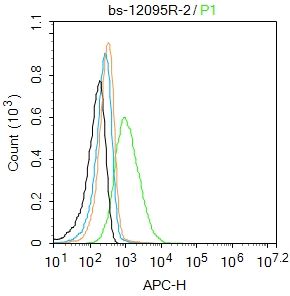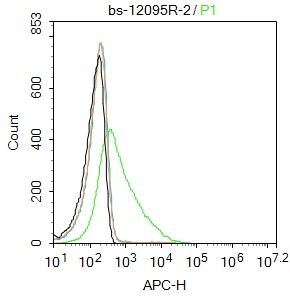GRID1 Polyclonal Antibody
Purified Rabbit Polyclonal Antibody (Pab)
- SPECIFICATION
- CITATIONS
- PROTOCOLS
- BACKGROUND

Application
| IHC-P, IHC-F, IF, ICC, E |
|---|---|
| Primary Accession | Q9ULK0 |
| Reactivity | Rat, Dog, Bovine |
| Host | Rabbit |
| Clonality | Polyclonal |
| Calculated MW | 110 KDa |
| Physical State | Liquid |
| Immunogen | KLH conjugated synthetic peptide derived from human GRID1 |
| Epitope Specificity | 501-600/1009 |
| Isotype | IgG |
| Purity | affinity purified by Protein A |
| Buffer | 0.01M TBS (pH7.4) with 1% BSA, 0.02% Proclin300 and 50% Glycerol. |
| SUBCELLULAR LOCATION | Cell membrane; Multi-pass membrane protein (By similarity). Cell junction, synapse, postsynaptic cell membrane; Multi-pass membrane protein (By similarity). |
| SIMILARITY | Belongs to the glutamate-gated ion channel (TC 1.A.10.1) family. GRID1 subfamily. |
| Important Note | This product as supplied is intended for research use only, not for use in human, therapeutic or diagnostic applications. |
| Background Descriptions | Glutamate receptors mediate most excitatory neurotransmissions in the brain and play an important role in neural plasticity, neural development and neurodegeneration. Ionotropic glutamate receptors are divided into two categories, namely NMDA receptors and kainate/AMPA receptors, both of which contain glutamate-gated, cation-specific ion channels. Kainate/AMPA receptors consist of seven structurally related subunits, designated GluR-1 to -7, and are primarily responsible for fast excitatory neurotransmissions carried out by glutamate. GluR-delta 1 (Glutamate receptor delta-1 subunit), also known as GRID1, is a multi-pass membrane protein that belongs to the kainate/AMPA receptor family and is expressed primarily in the brain. Localized to the cell junction and the postsynaptic cell membrane, GluR-delta 1 functions as a glutamate receptor that regulates synaptic transmissions in the central nervous system (CNS) and is thought to play an important role in synaptic plasticity. Defects in the gene encoding GluR-delta 1 are associated with schizophrenia, a chronic and severe brain disorder. |
| Gene ID | 2894 |
|---|---|
| Other Names | Glutamate receptor ionotropic, delta-1, GluD1, GluR delta-1 subunit, GRID1, KIAA1220 |
| Dilution | IHC-P=1:100-500,IHC-F=1:100-500,ICC=1:100-500,IF=1:100-500,ELISA=1:5000-10000 |
| Format | 0.01M TBS(pH7.4), 0.09% (W/V) sodium azide and 50% Glyce |
| Storage | Store at -20 ℃ for one year. Avoid repeated freeze/thaw cycles. When reconstituted in sterile pH 7.4 0.01M PBS or diluent of antibody the antibody is stable for at least two weeks at 2-4 ℃. |
| Name | GRID1 (HGNC:4575) |
|---|---|
| Synonyms | KIAA1220 |
| Function | Member of the ionotropic glutamate receptor family, which plays a crucial role in synaptic organization and signal transduction in the central nervous system. Although it shares structural features with ionotropic glutamate receptors, does not bind glutamate as a primary ligand (PubMed:38060673). Instead, forms trans-synaptic adhesion complexes with presynaptic neurexins and cerebellins, regulating NMDA and AMPA receptor activity and influencing synaptic plasticity through signal transduction (By similarity). In the presence of neurexins and cerebellins, forms cation-selective channels that are proposed to be gated by glycine and D-serine (By similarity). However, recent research disputes this ligand-gated cation channel activity (PubMed:39052831). Cation-selective ion channel can be triggered by GRM1 in dopaminergic neurons (By similarity). Also acts as a receptor for GABA, modulating inhibitory synaptic plasticity through non- ionotropic mechanisms (PubMed:38060673). |
| Cellular Location | Postsynaptic cell membrane; Multi-pass membrane protein |

Thousands of laboratories across the world have published research that depended on the performance of antibodies from Abcepta to advance their research. Check out links to articles that cite our products in major peer-reviewed journals, organized by research category.
info@abcepta.com, and receive a free "I Love Antibodies" mug.
Provided below are standard protocols that you may find useful for product applications.
If you have used an Abcepta product and would like to share how it has performed, please click on the "Submit Review" button and provide the requested information. Our staff will examine and post your review and contact you if needed.
If you have any additional inquiries please email technical services at tech@abcepta.com.













 Foundational characteristics of cancer include proliferation, angiogenesis, migration, evasion of apoptosis, and cellular immortality. Find key markers for these cellular processes and antibodies to detect them.
Foundational characteristics of cancer include proliferation, angiogenesis, migration, evasion of apoptosis, and cellular immortality. Find key markers for these cellular processes and antibodies to detect them. The SUMOplot™ Analysis Program predicts and scores sumoylation sites in your protein. SUMOylation is a post-translational modification involved in various cellular processes, such as nuclear-cytosolic transport, transcriptional regulation, apoptosis, protein stability, response to stress, and progression through the cell cycle.
The SUMOplot™ Analysis Program predicts and scores sumoylation sites in your protein. SUMOylation is a post-translational modification involved in various cellular processes, such as nuclear-cytosolic transport, transcriptional regulation, apoptosis, protein stability, response to stress, and progression through the cell cycle. The Autophagy Receptor Motif Plotter predicts and scores autophagy receptor binding sites in your protein. Identifying proteins connected to this pathway is critical to understanding the role of autophagy in physiological as well as pathological processes such as development, differentiation, neurodegenerative diseases, stress, infection, and cancer.
The Autophagy Receptor Motif Plotter predicts and scores autophagy receptor binding sites in your protein. Identifying proteins connected to this pathway is critical to understanding the role of autophagy in physiological as well as pathological processes such as development, differentiation, neurodegenerative diseases, stress, infection, and cancer.



